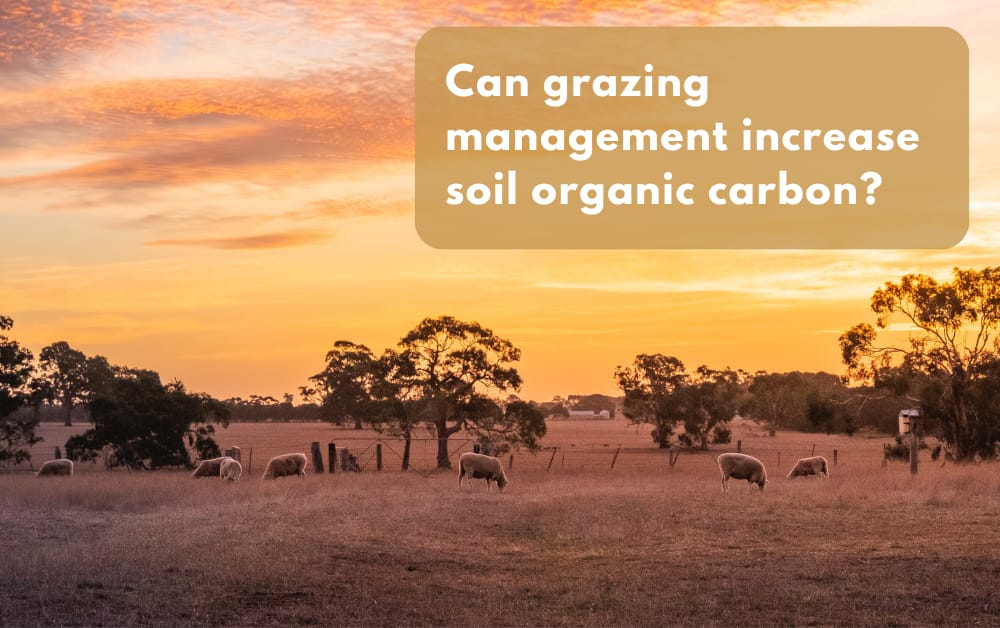From the desk of Suzannah, Project Coordinator.
Grazing management strategies used by livestock producers should be considered as part of efforts to optimise soil carbon sequestration, but other production or ecological benefits may outweigh potential soil carbon gains arising from improved grazing management.
This is the key finding from an extensive Australian review of published research undertaken by NSW Department of Primary Industries scientist Dr Sarah McDonald and her colleagues. The project is part of Meat & Livestock Australia’s Carbon Storage Partnership, which seeks to explore and develop pathways to carbon neutral red meat production by 2030 (CN30).
South Coast NRM is a partner in the Sustainable Pathways to CN30 initiative, and recently hosted a webinar on the topic. The webinar recording is available on our YouTube channel.
“Our review indicates that grazing intensity and strategy (timing, duration, frequency) can impact on key drivers of carbon sequestration, such as above and below ground biomass, pasture composition, groundcover, soil structure and soil nitrogen,” Dr McDonald said.
“However, the review also found a lack of consistent evidence in Australian research of measurable links between grazing intensity or strategy and soil organic carbon, other than the risk of increasing grazing intensity having a negative impact on soil carbon in some circumstances.”
Most studies reported no significant difference in soil organic carbon levels despite differences in grazing intensity and strategies. Using grazing management as a tool to build soil organic carbon may be effective in the short term where soil carbon stocks are degraded, although changes are likely outweighed by other factors (such as spatial and seasonal variability) which can have a greater overall impact on soil organic carbon than grazing management.
This means that while it is important to consider optimising soil carbon, for many producers the other benefits that come with improved grazing management are likely to be much more important. These benefits can include improvements in productivity and provision of ecosystem services such as biodiversity and ground cover.
It is important to acknowledge that few studies in Australia have examined the impact of grazing systems that were designed specifically to increase soil carbon, and over long time periods (>10 years) or at depth (>30cm). Over half of the studies included in this review monitored carbon in grazing systems that had been in place more than 8 years. Only five of the papers measured carbon at depths greater than 30cm. Further research is recommended to better understand these effects and the circumstances in which grazing intensity and strategy can increase soil organic carbon (SOC) in Australia to help achieve the goal of CN30.
“In some circumstances, when a range of elements including soil type, past management, climate, and other factors are stitched together, grazing management may play a role in significantly improving soil carbon over time,” Dr McDonald said. “If these circumstances align for an individual producer or property, then there is opportunity to explore soil carbon benefits.”
In these specific circumstances, soil carbon may increase when grazing is managed to increase pasture productivity and root allocation, promote deep-rooted perennial species or nitrogen-fixing legumes, improve soil physical and chemical properties, and reduce loss of carbon via erosion by maintaining ground cover. Generally, this is achieved under low or moderate grazing intensity, and by manipulating the timing of grazing and rest (such as in rotational grazing systems to promote growth and recovery of desired species).
It is important to note that this study considered the effects of grazing intensity and strategy (timing, frequency and duration of grazing), but did not review other pasture management changes such as the use of legumes and fertiliser, or land use changes such as reforestation, cropping to pasture changes or removing grazing entirely.
The review is published in the Journal of Environmental Management and is available online. A webinar was held during Soil Week to explore the findings further.
For further information contact Suzannah – suzannahm@southcoastnrm.com.au

